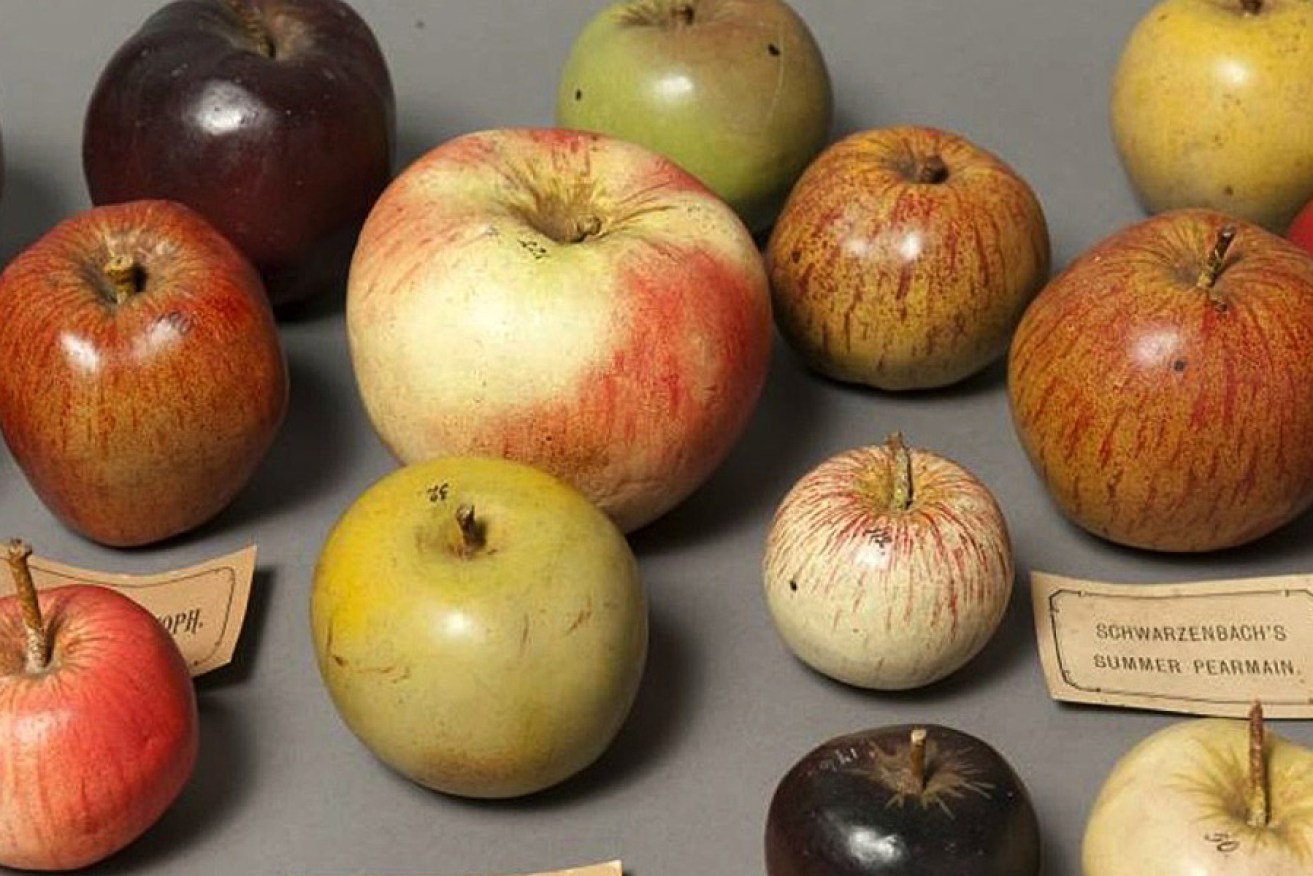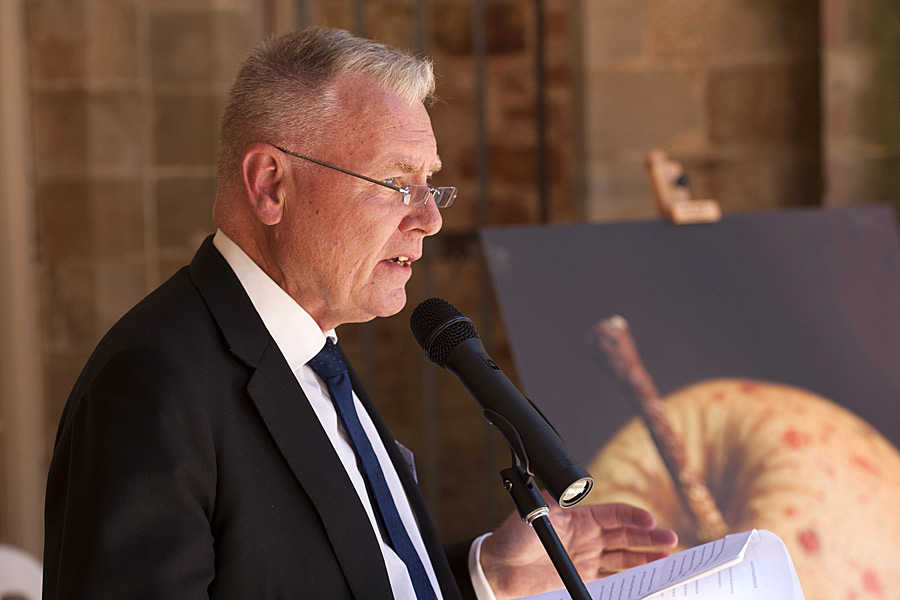Fruit flavours lost … and found


Model apples on display at the Museum of Economic Botany.
It’s very cool that local publication Imitation of Life – a visual catalogue has won the Museums Australia Multimedia and Publication Design Award at the Museums Australia conference in Launceston, Tasmania.
The book, by Tony Kanellos, Cultural Collections manager and curator at the Adelaide Botanic Gardens, explains the history of the amazing collection of 19th-century papiér mâché fruits held there. These fruits are accurate scientific models of 225 types of apple, 161 pears, and some stone fruits and sundries.
Principally a sombre set of beautiful full-page photographic portraits by Paul Atkins, and handsomely designed by Kate Burns, the book is quietly becoming an essential part of the collection of hard-core fruit-lovers, gardeners, orchardists and cider-lovers.
The fruit samples were made in Germany and sent to the colony in batches, over many years, so new South Australians had a reference set of the varieties available to them. Tellingly, most of these types no longer exist. As I wrote here upon its November launch, it is a book of ghosts.
Since the recent cider invasion of the drive-in kiddylikker fridges, this work has gained an unlikely significance. Most ciders are made from neutral-flavoured “filler” juice or frozen concentrate made from excess eating apples, and simply supply the sugar-addicted juvenile palate with a mouthful of fast, easy ethanol.
Professor David Mabberley delivered a telling speech at the book’s November launch at Marble Hill. A formidable plant scientist, Mabberley is former keeper of the Herbarium, Library, Art and Archives at the Royal Botanic Gardens at Kew. He currently sits at Universiteit Leiden in The Netherlands and the University of Oxford, but he’s best known for his own astonishing dictionary of plants, their classification and uses, Mabberley’s Plant-Book, now in its third edition.
“… among all the reinettes, pippins and court-pendus, most are unfamiliar today,” Mabberley said. “This makes them fascinating and an important lesson for a general public now mercifully [endowed] with an increasingly healthy interest in heritage fruits and vegetables; the collection helps us to understand what is already lost and what further we are in danger of losing at the hand of supermarket mores – in terms of apples, for instance, all that seems to be needed now in most parts of the world is one yellow, one red and one green.”
My interest in cider began in the early ’70s, when sulphidic Tasmanian brands were the go. But we also had Cobbley’s Cider in the Adelaide Hills. We’d regularly make the pilgrimage to that little shed near Norton Summit and buy flagons of still, cloudy scrumpy. Cobbley’s also made a freakish cult drink, Blue Moose, which was an aerated cider died sky blue with some unearthly chemical, delivered in a champagne bottle with a plastic stopper and a bright blue moose on the label.
Before Blue Moose went the way of all those ancient apples, the late Adelaide Review food critic, Howard Twelftree, infamously drank this by the pint, mixed with Cointreau on ice.
In about 1980, I discovered Darren Kelly’s orchard and cider factory, Kellybrook, in the Yarra Valley, along with the mysterious nature of true cider apples, like the quirky Kingston Black. No chop as an eating fruit, this soft little apple was easily pressed and delivered a beautiful flavour, but oxidised and browned too quickly for a table apple.
Kelly’s beautiful methode champenoise cider was a favourite trick drink for confusing alleged fine champagne experts – even that great wine industry doyen, judge and all-round rascal Len Evans OBE was tricked into declaring it to be a fine example of real champagne at a blind tasting.
After being lost in wine for a decade, I hit apples again when I lived out in the badlands at Dutton, and drank in the top pub at Truro, where wine tanker drivers would call in for a beer. I learned more about the Australian wine industry in that bar than one could in any other, and eventually found myself in trouble with the law when I learned from drivers’ delivery books that apple juice was being delivered to many very famous Australian wineries, none of which produced a cider.
The apple growers had had a nasty season with hail damage, and had cleverly pulped and juiced an entire crop for sale on the bulk market.
By watering the apple juice and fermenting it, some seemed convinced they could make a fair Sauvignon blanc from it, as that grape was seen to be the “new Chardonnay”, but was scarce in Australia, which was largely too hot for it.
I advised George Mackey, chairman of the Australian Wine and Brandy Corporation – now Wine Australia – that I was investigating this scam, so he sent his wine police in to test various wines they quietly bought in commercial liquor stores.
As apple juice naturally contains sorbitol, a sugar alcohol, and grapes don’t, the test they used to find apple juice in the wines simply involved testing for sorbitol. This powdery compound is used as a moistening agent in everything from tobacco to biro ink, and is a laxative if taken in concentrated form.
It gives beverages “mouthfeel”, that comforting, sightly oily mid-palate character that feels somehow luxurious. Used carefully with some flavourants, it can turn water into a half-reasonable emulation of white wine.
Eventually the New South Wales Health Department busted famous Hunter winemaker Murray Tyrrell for selling six wines containing sorbitol.
The irony was that Tyrrell denied buying apple juice concentrate, but admitted that he simply added sorbitol to his wines, which backfired because sorbitol is an illegal additive to wine in Australia, a fact which Tyrrell should have known, as he’d been on the NSW committee which regulated such things.
Tyrrell sued me, as author, David Dale, as editor, and Kerry Packer, as publisher, for defamation when I wrote of these findings in The Bulletin. The case dragged on for years; eventually I discovered, by accident, in The Exeter front bar (of course), that the winemaker had withdrawn, and paid all legal expenses and costs.
These must have been significant, given the number of silks engaged.
The other wineries that had taken tankers of apple juice were never prosecuted.
That was a long time ago, and the apple orchards have since shrunk to a tragic degree, especially to those who love a true, complex, hearty cider, or simply a better range of flavours in their fruit bowl.
In Tasmania alone, the old Apple Isle, the number of apple orchards has shrunk, since 1986, from about 1000 to only 30. Foremost among these is Australia’s biggest organic apple planting, Willie Smith and Sons orchard and Stone House cidery. Along with Adelaide Hills maker Lobo, this family produces what I consider to be our best, most complex and delightful cider in any volume.
Before you go guzzling some simple sorbitol-riddled “cider” from the local kiddylikker fridge, go visit our magical Museum of Economic Botany in the Botanical Gardens, take a long hard gaze at those beautiful model apples on display, and wonder what marvels of flavour we’ve lost.
Imitation of Life – a visual catalogue can be bought ($69) at the Diggers rare seeds and book shop behind the Museum of Economic Botany in the Botanic Gardens on North Terrace. To read Professor Mabberley’s speech in full, and read my original review of this fine volume, go to my blog.





